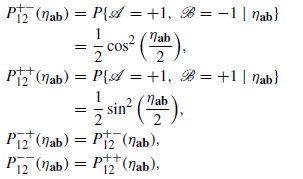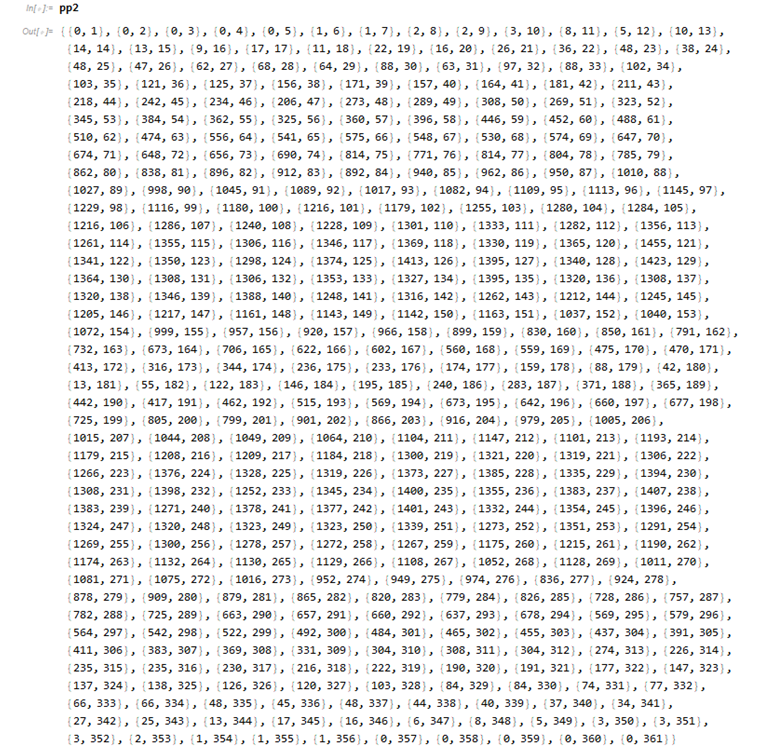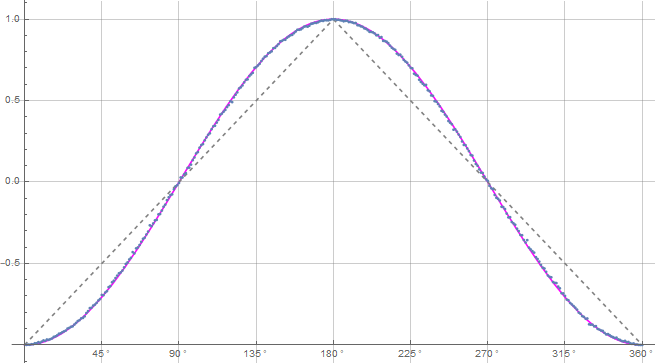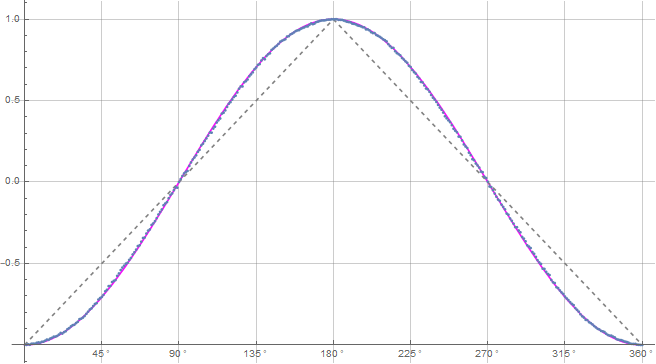That is sort of like my pp2.
Code: Select all
{{0, 1}, {0, 2}, {0, 3}, {0, 4}, {0, 5}, {1, 6}, {1, 7}, {2, 8}, {2,
9}, {3, 10}, {8, 11}, {5, 12}, {10, 13}, {14, 14}, {13, 15}, {9,
16}, {17, 17}, {11, 18}, {22, 19}, {16, 20}, {26, 21}, {36,
22}, {48, 23}, {38, 24}, {48, 25}, {47, 26}, {62, 27}, {68,
28}, {64, 29}, {88, 30}, {63, 31}, {97, 32}, {88, 33}, {102,
34}, {103, 35}, {121, 36}, {125, 37}, {156, 38}, {171, 39}, {157,
40}, {164, 41}, {181, 42}, {211, 43}, {218, 44}, {242, 45}, {234,
46}, {206, 47}, {273, 48}, {289, 49}, {308, 50}, {269, 51}, {323,
52}, {345, 53}, {384, 54}, {362, 55}, {325, 56}, {360, 57}, {396,
58}, {446, 59}, {452, 60}, {488, 61}, {510, 62}, {474, 63}, {556,
64}, {541, 65}, {575, 66}, {548, 67}, {530, 68}, {574, 69}, {647,
70}, {674, 71}, {648, 72}, {656, 73}, {690, 74}, {814, 75}, {771,
76}, {814, 77}, {804, 78}, {785, 79}, {862, 80}, {838, 81}, {896,
82}, {912, 83}, {892, 84}, {940, 85}, {962, 86}, {950, 87}, {1010,
88}, {1027, 89}, {998, 90}, {1045, 91}, {1089, 92}, {1017,
93}, {1082, 94}, {1109, 95}, {1113, 96}, {1145, 97}, {1229,
98}, {1116, 99}, {1180, 100}, {1216, 101}, {1179, 102}, {1255,
103}, {1280, 104}, {1284, 105}, {1216, 106}, {1286, 107}, {1240,
108}, {1228, 109}, {1301, 110}, {1333, 111}, {1282, 112}, {1356,
113}, {1261, 114}, {1355, 115}, {1306, 116}, {1346, 117}, {1369,
118}, {1330, 119}, {1365, 120}, {1455, 121}, {1341, 122}, {1350,
123}, {1298, 124}, {1374, 125}, {1413, 126}, {1395, 127}, {1340,
128}, {1423, 129}, {1364, 130}, {1308, 131}, {1306, 132}, {1353,
133}, {1327, 134}, {1395, 135}, {1320, 136}, {1308, 137}, {1320,
138}, {1346, 139}, {1388, 140}, {1248, 141}, {1316, 142}, {1262,
143}, {1212, 144}, {1245, 145}, {1205, 146}, {1217, 147}, {1161,
148}, {1143, 149}, {1142, 150}, {1163, 151}, {1037, 152}, {1040,
153}, {1072, 154}, {999, 155}, {957, 156}, {920, 157}, {966,
158}, {899, 159}, {830, 160}, {850, 161}, {791, 162}, {732,
163}, {673, 164}, {706, 165}, {622, 166}, {602, 167}, {560,
168}, {559, 169}, {475, 170}, {470, 171}, {413, 172}, {316,
173}, {344, 174}, {236, 175}, {233, 176}, {174, 177}, {159,
178}, {88, 179}, {42, 180}, {13, 181}, {55, 182}, {122, 183}, {146,
184}, {195, 185}, {240, 186}, {283, 187}, {371, 188}, {365,
189}, {442, 190}, {417, 191}, {462, 192}, {515, 193}, {569,
194}, {673, 195}, {642, 196}, {660, 197}, {677, 198}, {725,
199}, {805, 200}, {799, 201}, {901, 202}, {866, 203}, {916,
204}, {979, 205}, {1005, 206}, {1015, 207}, {1044, 208}, {1049,
209}, {1064, 210}, {1104, 211}, {1147, 212}, {1101, 213}, {1193,
214}, {1179, 215}, {1208, 216}, {1209, 217}, {1184, 218}, {1300,
219}, {1321, 220}, {1319, 221}, {1306, 222}, {1266, 223}, {1376,
224}, {1328, 225}, {1319, 226}, {1373, 227}, {1385, 228}, {1335,
229}, {1394, 230}, {1308, 231}, {1398, 232}, {1252, 233}, {1345,
234}, {1400, 235}, {1355, 236}, {1383, 237}, {1407, 238}, {1383,
239}, {1271, 240}, {1378, 241}, {1377, 242}, {1401, 243}, {1332,
244}, {1354, 245}, {1396, 246}, {1324, 247}, {1320, 248}, {1323,
249}, {1323, 250}, {1339, 251}, {1273, 252}, {1351, 253}, {1291,
254}, {1269, 255}, {1300, 256}, {1278, 257}, {1272, 258}, {1267,
259}, {1175, 260}, {1215, 261}, {1190, 262}, {1174, 263}, {1132,
264}, {1130, 265}, {1129, 266}, {1108, 267}, {1052, 268}, {1128,
269}, {1011, 270}, {1081, 271}, {1075, 272}, {1016, 273}, {952,
274}, {949, 275}, {974, 276}, {836, 277}, {924, 278}, {878,
279}, {909, 280}, {879, 281}, {865, 282}, {820, 283}, {779,
284}, {826, 285}, {728, 286}, {757, 287}, {782, 288}, {725,
289}, {663, 290}, {657, 291}, {660, 292}, {637, 293}, {678,
294}, {569, 295}, {579, 296}, {564, 297}, {542, 298}, {522,
299}, {492, 300}, {484, 301}, {465, 302}, {455, 303}, {437,
304}, {391, 305}, {411, 306}, {383, 307}, {369, 308}, {331,
309}, {304, 310}, {308, 311}, {304, 312}, {274, 313}, {226,
314}, {235, 315}, {235, 316}, {230, 317}, {216, 318}, {222,
319}, {190, 320}, {191, 321}, {177, 322}, {147, 323}, {137,
324}, {138, 325}, {126, 326}, {120, 327}, {103, 328}, {84,
329}, {84, 330}, {74, 331}, {77, 332}, {66, 333}, {66, 334}, {48,
335}, {45, 336}, {48, 337}, {44, 338}, {40, 339}, {37, 340}, {34,
341}, {27, 342}, {25, 343}, {13, 344}, {17, 345}, {16, 346}, {6,
347}, {8, 348}, {5, 349}, {3, 350}, {3, 351}, {3, 352}, {2,
353}, {1, 354}, {1, 355}, {1, 356}, {0, 357}, {0, 358}, {0,
359}, {0, 360}, {0, 361}}
That didn't work so good. I should have taken a picture. First number of the pair is how many ++'s per the angle (a-b) for the second number. Well, I can easily do "a" for the second number and "b" for the 3rd.
Here is a picture that is easier to understand perhaps. The counts are large on some because 1 million trials.
The total of the ++'s is 251613 for all "a" and "b". Which is what we would expect. About 1/4 of the trials.
.
and
over all the (a-b) angles. Lo and behold, when we do that we obtain,
,
,
.





